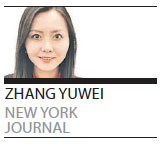China's middle class keeps luxury brands on their toes

Black-and-white-themed Coco Chanel's taste and legacy has created a new fashion trend in China - one of the world's fastest growing markets for luxury brands - according to the new World Luxury Index on China.
Chanel overtook Louis Vuitton - both French - thanks to a rising interest in various product segments, particularly beauty, according to the report done by the Digital Luxury Group, a luxury industry market intelligence firm.
"Chanel is benefiting from an important level of interest in China, mostly emanating from strong interest from Chinese consumers in its beauty products, which Louis Vuitton does not have," said David Sadigh, founder and CEO of Digital Luxury Group.
But, he added, Louis Vuitton - originated mainly from the fashion segment, which accounts for almost three-quarters of total interest in the brand - remains the best example of a high-end brand that became "mainstream".
"You can link this approach to other massive high-end brands that had a strong development in China with affordable product at an entry level, such as Gucci, Tiffany, Dior and Chanel," said Sadigh.
Louis Vuitton's parent company LVMH in April posted lower-than-expected earnings, due to weaker sales results in China for the first quarter. But its competing brand, Burberry, No 21 on the index, caught up, posting a 16 percent increase in its China sales for the same period.
"Louis Vuitton has reported a disappointing first quarter, while brands from different segments ranging from Chanel to Coach or Burberry are continuing to grow," said Sadigh. "In order to stay ahead of the game, brands must have the ability to adapt quickly, thus reducing the risk of brand saturation.
"Louis Vuitton has been pushing very hard in the Chinese market, suffering from saturation," noted Sadigh. "LVMH understood this very well, reacting immediately, announcing price increases and production of higher end leather products."
Leading products that shape the Chinese luxury market include cars - which account for 54 percent of all luxury items - beauty products, watches and jewelry, all dominated by European and American brands.
The brands that sit on the Top 50 most sought-after list in China include Audi, BMW, Chanel, Estee Lauder, and Louis Vuitton (six car brands are in the top 10).
"The market is dominated by heavyweights, but it's actually less and less the case," Sadigh said. "Small and niche brands are reporting a more positive growth than the big players."
Some brands new to this year's Top 50 list include Elizabeth Arden (No 43) and Rado (No 50), while Salvatore Ferragamo and Moncler dropped out of this year's rankings. The index also ranks hospitality, with Sheraton, Hilton, and Intercontinental topping the list as most sought-after hotel brands in China.
"Many brands expected that an increase in Chinese sophistication would reduce the cultural gap with their overseas consumers," said Pablo Mauron, general manager of Digital Luxury Group's China office. "In some cases, it actually contributed to the development of unique local preferences, independent from Western tastes, thus challenging luxury brands in terms of product offering, but also opening up the way for new opportunities to grow in the Chinese market."
China's growing middle class has been a main driver for the consumption of foreign luxury brands. By 2022, China's middle class is expected to triple to 630 million, an increase from 230 million in 2012, according to a recent study by the China-United States Exchange Foundation.
China's affluent shoppers have average annual earnings of between $19,500 and $90,000 and are expected to be the driver for the future growth of luxury markets, according to Exane BNP Paribas, an equity research firm.
"The growing middle class is getting more and more sophisticated, as a consequence, there is a will to distinguish themselves from the crowd, leading the consumers to more exclusive brands," Sadigh said.
Despite the potential in the Chinese luxury market, the level of competition is high, noted Sadigh, adding that foreign brands should come up with strategies that increase their local presence and create a better connection to the consumers through, for instance, social media such as Sina Weibo, a popular Chinese micro-blogging site similar to Twitter.
"There will be more competition and more fragmentation," said Sadigh. "Some brands may be failing in China since the market doesn't mean double-digit growth for everybody anymore."
























